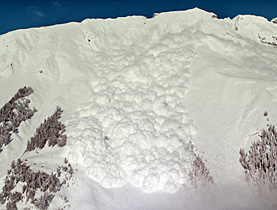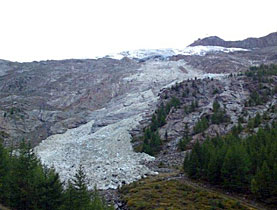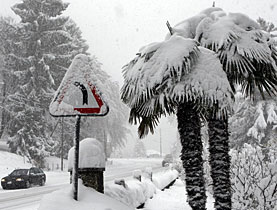Experts get down to snowbusiness

Is snow safety a high tech matter or can intuition play a role? And just how much can people withstand in an avalanche?
These are just some of the topics being investigated at the International Snow Science Workshop (ISSW), being held for the first time in Europe in the mountain resort of Davos.
More than 500 snow professionals have been gathering for the five-day meeting, which ends on Friday. It is reputed to be the foremost forum of its kind.
“It’s certainly the one conference where practitioners such as safety officials and scientists meet and the idea is to bring the best minds in snowbiz together for an exchange between theory and practice,” said Jürg Schweizer, co-chair of the conference and member of the Institute for Snow and Avalanche Research (SLF) in Davos, which organised the event.
Until now the ISSW has always been held in North America. Davos, whose SLF is one of the oldest and largest institutes worldwide dealing with snow research, seemed a logical choice for its European debut.
“It’s a unique place in terms of avalanche research,” Schweizer told swissinfo.ch. “You can see all types of avalanche protection measures here, you just have to look out of the window and you see defence structures or devices to artificially release avalanches. It’s a kind of avalanche park.” Just the ticket for hundreds of snow experts.
The European location meant that more emphasis was placed on avalanche protection and risk management, as the Alps are more densely populated than their North American counterparts. In Switzerland alone, around 20 people die in avalanches per winter.
Iron Man
High tech is helping to increase understanding. Delegates saw how one Spanish-designed small sensor could be thrown into an avalanche to show how it moves and what forces it produces.
Mike Jenkins of Utah State University in the United States has been measuring the human impact of an avalanche. For this he developed Iron Man, a steel crash test dummy, which was the star of a recent National Geographic documentary.
“In the film you can see he ends up rotating 11 times, two times per second, and ends up going 40 kilometres per hour, ten times the acceleration of gravity. He’s then buried 30 centimetres deep,” Jenkins told swissinfo.ch.
Iron Man only experienced a relatively small avalanche, typical of what humans might trigger in the backcountry. Jenkins plans to extend his research further from this case study. However, the professor said the message was clear – don’t get “avalanched”.
“Don’t think that all of the rescue gear, like air bags or beacons are going to save you, because it’s a very violent ride and even if you survive you’ll probably be seriously hurt,” he said.
Gut feeling
However, not everyone relies on high tech. Schweizer said that a panel discussion on the issue of intuition had revealed two schools of thought: one that believes that people are fooled into making bad decisions by it and one that says that intuition, often based on long experience, is essential.
Jan Mersch, a German mountain guide and psychologist, looked into how very experienced mountain guides reacted in avalanche situations. He wanted to see whether their actions fitted into a “recognition-primed decision making process”, which stresses the role of experience for developing intuition.
“The decisions they made based on their intuition were quite good and reasonable and you can filter these intuition-based decisions down to good hard facts that are, however, not conscious,” Mersch explained.
The guides tended to react to patterns or facts they recognised – such as the wind blowing from the left and causing tears to freeze or what it felt like to walk on the snow. Mersch says it would be interesting to see what produces this recognition, as it could help beginners spot potential dangers.
Snowless at the ISSW
The big snow nations were all represented at the conference, including Canada, New Zealand and Japan. Scenarios, forecasting and safety were all discussed and illustrated.
So it was perhaps a little surprising to hear from somewhere with no mountains at all.
The Netherlands Snow Safety Center has been teaching the snow-loving Dutch – one million go to the Alps each year– about icy dangers. But how does it solve the problem of being completely flat?
“We use the beach, we have the same wind structures there that we find in the snow,” said the center’s Rolf Westerhof. Specially designed education courses are also run.
It seems that any nation can get bitten by the snowbusiness bug.
Isobel Leybold-Johnson in Davos, swissinfo.ch
The International Snow Science Workshop (ISSW) was organised by the Institute for Snow and Avalanche Research in Davos, eastern Switzerland, for the first time in Europe.
Around 500 international experts were attending, from around 24 countries.
Among them were mountain guides, representatives of safety authorities, engineers and researchers.
The event ran from September 27 to October 2
Among the topics highlighted was how to estimate the economic value of an avalanche bulletin, as prepared by the SLF.
This is currently free, but a survey asked how much people were prepared to pay for an improved bulletin. “It came out that users are on average willing to pay SFr40-45 ($38-43)[annually] for this improved service,” said Christoph Rheinberger, who presented the research.
He said that the SLF was not planning to charge anything for the bulletin as it is a public service plaid by the taxpayer. It is estimated that without this bulletin, the rate of 20 avalanche fatalities per winter would double, he said. Rheinberger said that further applications such as the one being developed for the iPhone could be charged for.
Delegates could also see how Swiss Experiment, which uses high tech to collect environmental data and then makes it widely available to scientists, would be recording snow distribution in Davos this winter. This will enable predictions on where snow should build up under different wind conditions.

In compliance with the JTI standards
More: SWI swissinfo.ch certified by the Journalism Trust Initiative




You can find an overview of ongoing debates with our journalists here. Please join us!
If you want to start a conversation about a topic raised in this article or want to report factual errors, email us at english@swissinfo.ch.